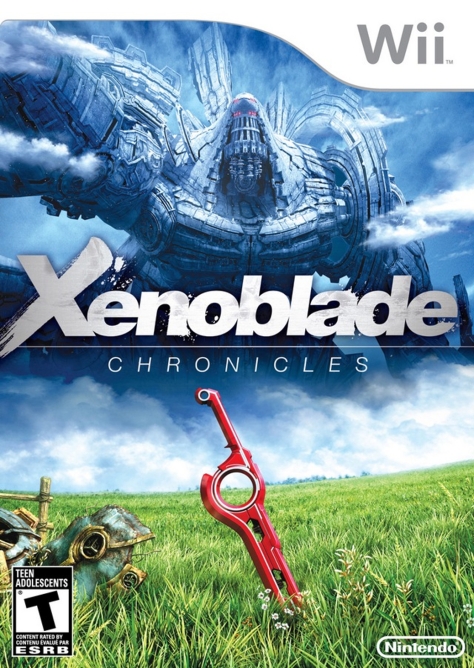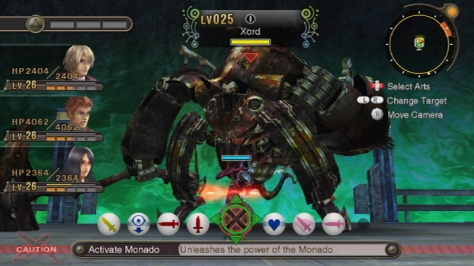
While I have a soft spot for them, I just don’t have the time to devote to lengthy RPGs like I used to. So before I started Xenoblade Chronicles, I was fearful it’d take me months to complete. Instead, I was immediately hooked on Monolith Soft’s seminal Wii RPG and saw credits within a month, having found a couple hours for it each night. Originally published by Nintendo of Japan on June 10, 2010, it took the grassroots Operation Rainfall movement for it to see the light of day in the United States. Half a year after it was localized for the European market, and with British voice-acting still intact, it released here on April 6, 2012. Featuring an enthralling storyline, active combat reminiscent of MMORPGs, a robust collection of interlocking gameplay systems, and expansive areas chock full of enemies and distractions, it was a supremely enjoyable, highly addictive experience that has me seriously contemplating jumping into Xenoblade Chronicles X.
Reminiscent of the World Turtle myth, Xenoblade Chronicles opened with an origin story of the two dueling titans that all life lived upon. An uncommon setup amongst video games, I was immediately intrigued by this concept. The titans, the natural Bionis and the mechanical Mechonis, remained frozen in battle, an analogy for the perpetually warring species calling them home. This grand scale of ancient conflict informed the antagonism felt between the Homs and Mechon and eventually came to the fore when the titans once again awoken. However, the impetus driving the game forward initially was more personal: a quest of revenge.

After an attempt to combat invading Mechon resulted in the death of Fiora, Shulk’s childhood friend and love interest, he and Reyn, another longtime buddy, set out to avenge her death and destroy all Mechon. Wielding the Monado, a powerful sword integral to the origin story and uniquely effective against Mechon, they stood a chance. Only usable by those the sword chooses, it also granted Shulk the power of foresight. Many mysteries surrounded the Monado, such as why it chose him and the blade’s ineffectiveness against “faced” Mechon, but over the course of the game’s seventy hour runtime, all was revealed. As they journeyed on the Bionis, they recruited allies, provided assistance to various communities, and frequently engaged attacking Mechon.
Joining their cause early on and for many of the same reasons, the healing sniper Sharla became the most vital member of my combat party. Her healing abilities were unmatched, allowing two other characters to ravage enemies as she kept them alive from a distance. With the Monado, Shulk was predictably strong and essential when fighting Mechon. Though I could play as anyone, I most often controlled him. Reyn was an offensive tank, great for drawing aggro and allowing me to execute Shulk’s special attacks with positional bonuses in mind. Peculiarly, the comic relief Nopon furball Riki was a defensive tank, fundamental to my success against late-game bosses. The least utilized members of my party were Dunban and Melia. The former was Fiora’s older brother and an offensive powerhouse whereas the latter was the summoner princess to a race of avian humanoids known as the High Entia.

With elements like a basic auto attack and cool down meters, the battle system was influenced more by MMORPGs than Monolith Soft’s previous turn-based work. Fights were initiated when enemies spotted the party or when I drew a weapon, and combat took place there and then, without being ushered off to a separate fight scene. I had full control over one party member while the actions of the other two were dictated by AI. Considering the game’s mechanical themes, it’s fitting that over time, I executed battle strategies with a robotic repetition. Unlike the other party members, Shulk never learned more special attacks, or Arts, than he could use at any one time. Because I grew so familiar with him, I optimized the order in which I’d use his Arts, beginning every battle identically. As the game progressed, each battle played out differently based on a range of factors, despite my formulaic adherence to Shulk’s Art cool downs.
Even during lengthy encounters, the pace was brisk. I was constantly moving around, situating Shulk to take advantage of positional bonuses, using his Arts as they became available, chaining attacks with allies: it was very involving. I rarely passed up the opportunity to clash with enemies, because I found it fun to do so, but more than that because I was driven by an addictive, multifaceted progression treadmill. Besides getting hooked by the power fantasy inherent in earning experience and money to become stronger and better equipped, I spent copious time leveling up Arts, completing character-specific skill trees, and improving the bonds between characters, all furthered through battle victories.

In addition to the myriad of ways improved the party’s combat readiness, I undertook an insignificant fraction of the hundreds of sidequests, doled out by the hundreds of named NPCs populating the game. Most were simple fetch or kill quests but nonetheless rewarded me well for my time. Many entangled multiple NPCs whose relationships and personalities were filled in and connected together on a massive Affinity Chart, which was an enormous sidequest itself. In regards to long-form sidequests, the more engaging ones revolved around the reconstruction of a destroyed colony. I helped to rebuild it by cashing in collectible items and convincing NPCs to relocate there after I’d helped them out a few times.
Settlements were large, bustling with NPCs just as the wild areas were brimming with all manner of wildlife. Enemies dotted the massive environments of the Bionis and Mechonis, high-level beasts mingling alongside more appropriate fare, like in Final Fantasy XII. I was careful to avoid monsters that were out of my league; otherwise they’d down the party in seconds. Landmarks and secret areas were scattered ubiquitously as well, granting fast travel once discovered. A full range of climates was represented, from tropical jungles to snowy mountains, each with unique collectables and monsters. Factoring in the entertaining battles and numerous distractions, exploring specific areas could take upwards of a couple hours. For those reasons, in addition to the fittingly eclectic soundtrack, it never felt like a chore.

Primarily composed by three parties, each with distinctive styles, the 4 disc soundtrack was a diverse compilation matching the game’s extensive scope. Whether I was exploring a dank cave, facing an onslaught of Mechon, or witnessing a somber cutscene, the experience was scored with an apt, often catchy song. It became routine for me to seek out song information after my sessions as I’d almost certainly have heard something pleasing enough for continued listening. Manami Kiyota composed most of the Zenlike, lush environmental music like “Satorl Marsh.” Accordingly, it was surprising to learn she was behind the imposingly seductive boss theme “Zanza the Divine.” Other heavy tracks like “You Will Know Our Names” reminded me of the inspirational metal from Power Rangers and Dragon Ball Z. These were generally composed by the threesome ACE+ but like Kiyota-san, their output was disparate; they were also responsible for the hauntingly minimal “Valek Mountain (Night).” Yoko Shimomura contributed few tracks in comparison but I found them universally worthwhile.
As the party’s understanding of the Mechon’s aggression grew, it belied their initial quest for revenge. Perhaps unsurprisingly, they discovered their races weren’t so different. As calamity unfolded, they found joint cause in survival against gods, not unlike the residents of Tellius in Fire Emblem: Radiant Dawn. (Additionally, both games featured protagonists crucially inhabited by divine beings.) Long held suspicions of mine bore out as other story twists astonished me. From its beginnings as a simple revenge tale, the storyline evolved to encompass broader philosophical musings such as agency and the coexistence of man and machine. It was an epic game, one I’ll not soon forgot.

When credits rolled I was immensely satisfied that with the time I devoted to Xenoblade Chronicles. At first I was hesitant to play, fearing it’d take months to finish. Instead, I devoured it in the course of one, averaging a two and a half hour session every day. That’s not counting the extra time I spent researching the soundtrack, either. I was sufficiently motivated to see where the plot went, especially as it wound down, but it was the collection of interlocking gameplay mechanics that had me hooked. The lively combat was enjoyable and challenging in its own right, as was exploring the expansive world. Supplemented by numerous systems to improve characters and bountiful sidequests as they were, however, and each session turned into a jog on the dopamine releasing progression treadmill. After a little rest, I suppose I’ll jump onto the Xenoblade Chronicles X treadmill soon…

4 thoughts on “Xenoblade Chronicles [Wii] – Review”